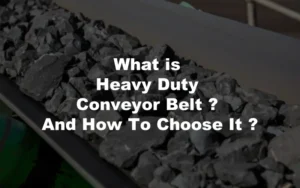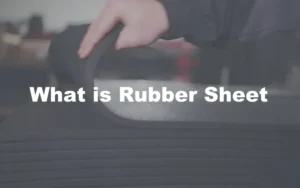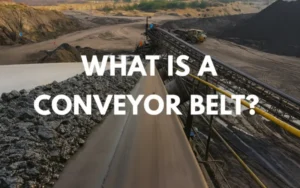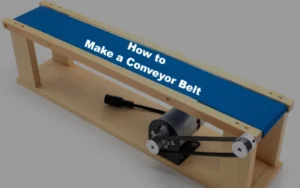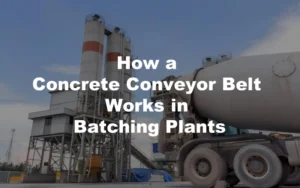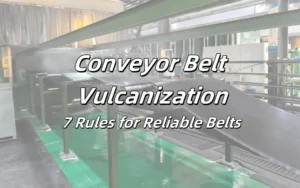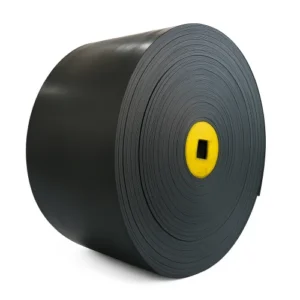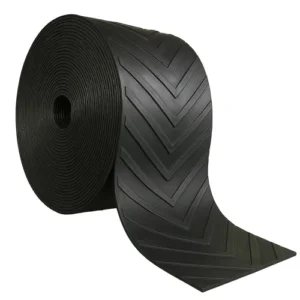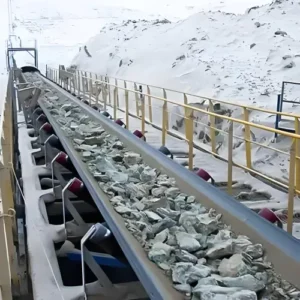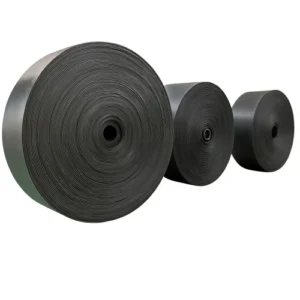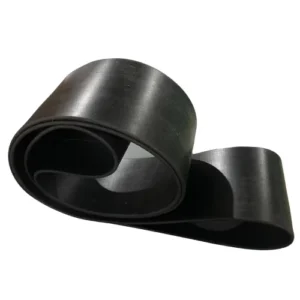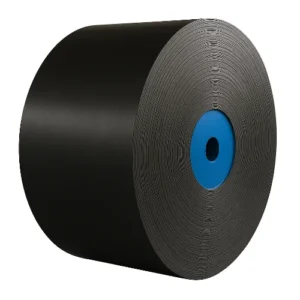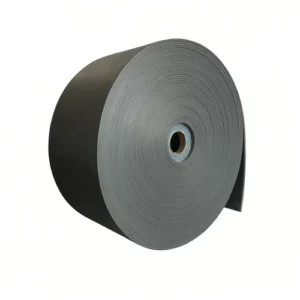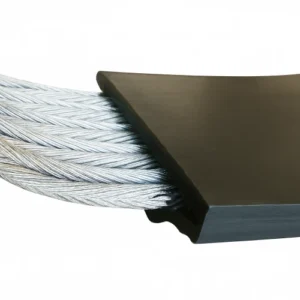Surface bubbles between layers
Surface impurities, granules, or pinholes
Edge feathering or curl
Discoloration or surface hardening from heat
Scratches caused by belt cleaner misalignment
Delamination or ply separation
Uneven belt thickness
Fabric misalignment or steel cord offset
Misaligned splice layers
Edge tearing near winged tail pulleys
Insufficient bonding strength
Low tensile strength or premature stretching
Poor abrasion or tear resistance
Heat damage or thermal shock failure
Blistering or edge bulging

Let’s face it—rubber conveyor belts don’t exactly scream glamour. They’re not flashy, they don’t have Wi-Fi, and no one’s writing love songs about them. But in industries like mining, cement, ports, or power plants? These belts are the unsung heroes, silently carrying tons of materials every hour, every day—until something goes wrong.
And when it does go wrong, it’s not a quiet kind of problem. Conveyor belt damage can throw your entire operation into chaos faster than you can say “unplanned downtime.” Production halts. Costs spike. Your boss starts asking uncomfortable questions.
Procurement folks, this one’s for you. You’re not just buying rubber. You’re buying performance, safety, and peace of mind. But with so many belts flooding the market, separating a durable workhorse from a soon-to-fail strip of disappointment isn’t easy. Many conveyor belt problems only show their true colors after the belt’s already in motion—literally.
So, buckle up. This guide dives deep into the world of rubber conveyor belt quality—what can go wrong, who’s to blame, and how you can keep your operations rolling smoothly. Let’s make smart belts sexy again.
Why Should Buyers Care About Conveyor Belt Quality?
Let’s be honest—no one dreams of becoming a conveyor belt expert. But when conveyor belt damage brings your million-dollar operation to a grinding halt, suddenly that rubber loop feels very… important.
In industries where time equals tons, a faulty belt doesn’t just delay shipments—it triggers production shutdowns, safety hazards, and very awkward meetings with upper management. That’s not just inconvenient—it’s expensive.
The tricky part? Many conveyor belt problems don’t wave red flags on Day One. Delamination, uneven thickness, low tensile strength—they hide, waiting to strike mid-operation. And once they do, blame starts bouncing around like loose gravel. Was it the manufacturer? The installer? The guy who bought it on discount?
That’s why procurement isn’t just about finding the cheapest belt. It’s about understanding what quality looks like, asking the right questions, and reading between the datasheet lines. When you know how to judge quality transparently—through test reports, production specs, and visual checks—you’re not just buying a belt. You’re building a supplier relationship based on clarity and trust.
Because once you can pinpoint whether conveyor belt damage is due to poor manufacturing or improper use, post-sale disputes shrink. Collaboration improves. And suppliers stop seeing you as “just another buyer”—you become a partner they respect.
In short: quality-conscious buyers don’t just avoid disaster. They build better supply chains. And in this business, that’s worth more than any price tag.

Types of Conveyor Belt Damage: A Full Breakdown from Surface to Structure
When a conveyor belt fails, it’s rarely a surprise to the belt—it usually saw it coming long before the operators did. The challenge lies in recognizing those early signs of conveyor belt damage before your production line grinds to an unscheduled stop.
Here are four major types of conveyor belt problems, categorized by their origin and behavior.
1. Surface Issues: The Subtle First Warnings
You might think the surface is just skin-deep—but in belts, it’s often where damage introduces itself politely before it gets aggressive.
- Air bubbles trapped between plies form during the forming process if layers aren’t pressed tightly, leaving tiny voids that eventually expand under tension.
- Visible dust specks, granules, or unmixed fillers often result from poor compound preparation or airborne contamination during calendaring.
- Edge fuzz, curl, or uneven trimming shows that the belt may have been cut under tension or with dull tooling.
- Hard spots or discolored patches could mean the belt was overheated in vulcanization, compromising elasticity.
- Linear abrasions from belt cleaners suggest pressure misalignment that can evolve into surface cracking.
Each of these signs can indicate deeper manufacturing issues. If ignored, they become the gateway to more severe conveyor belt damage down the road.

2. Structural Issues: Where the Real Trouble Builds
The outer surface might pass inspection, but what’s hidden beneath can tell a very different story.
- Layer separation usually results from improper bonding pressure or uneven curing, creating zones of weakness.
- Thickness irregularities create load imbalance and can cause rapid wear in isolated areas.
- Off-center reinforcement fabricsor misaligned steel cords disrupt running stability, leading to progressive belt misalignment.
- Poor splice geometry interferes with tensioning and causes concentrated fatigue over time.
- Edge tearing near pulleys often stems from structural asymmetry, especially under repeated directional changes.
These aren’t cosmetic issues—they’re long-term liabilities disguised as minor flaws.

3. Performance Problems: When the Belt Just Doesn’t Hold Up
A brand-new belt can still deliver poor results if the core design or materials are compromised.
- Weak adhesive strength allows layers to shift under load, reducing overall stability.
- Low tensile capacity leads to stretch, sag, and snapping under normal duty cycles.
- Insufficient abrasion or tear resistance causes belts to wear out far too soon in harsh or jagged conditions.
- Heat sensitivity leads to brittleness and cracks when conveying high-temperature materials.
These performance failures don’t just cost you belts—they cost time, trust, and operating capital.

4. Post-Use Feedback: When Real Work Reveals Real Problems
Some issues are only visible after real-world use—but that doesn’t mean they’re your fault.
- Splice blowouts within weeks point to improper joint pressure or misaligned angles during assembly.
- Edge deformation, wandering tracking, and curl are often the result of manufacturing inconsistencies rather than user error.
- Blistering—a raised bubble-like formation—often comes from long-term moisture penetration or chemical exposure, distinct from forming-stage air bubbles.
- Material impact damageand foreign object scarring are sometimes operational—but when they happen too often, it may reflect insufficient resilience in the belt design.
Knowing how to read post-use conveyor belt damage helps you improve both future selections and supplier accountability.
Identifying Manufacturing-Related Conveyor Belt Damage: What Buyers Should Really Watch For
Conveyor belt damage can result from a wide range of causes, including operational misuse, environmental stress, and—in many cases—manufacturing-related flaws. For buyers, the ability to distinguish between these sources is essential. It not only supports fair dispute handling but also enables more informed procurement decisions in the long run.
Here are the most common conveyor belt problems that originate from the production floor—and how you can identify them.
1. Delamination and Layer Separation
When the layers of a conveyor belt begin peeling apart early in its service life, this is rarely caused by external use. Instead, it typically points to problems in the forming and vulcanization stages of manufacturing, where the bonding process is critically defined.
The root causes often include:
- Insufficient compression during the forming stage, which leads to air entrapment or incomplete contact between layers before vulcanization begins.
- Uneven pressure or temperature in the flat-plate vulcanizing press, resulting in areas that do not achieve full cure.
- Under-curing, not in the general sense of insufficient vulcanization, but specifically due to vulcanization time being too short for the specific rubber formulation being used.
In our own production, for example, we perform rubber-specific curing tests for each batch to determine the precise optimal vulcanization time under defined temperature and pressure settings. Skipping or misapplying this step leads to incomplete molecular cross-linking, which weakens the bond between plies and causes early conveyor belt damage under load.
This is a critical manufacturing defect, and if detected, the supplier should be expected to provide detailed vulcanization parameters and sample test data as part of post-failure investigation.

2. Inconsistent Belt Thickness
A high-quality conveyor belt must maintain uniform thickness across its entire profile. When thickness variation occurs, it’s typically due to misaligned calendering equipment or unstable pressure during the rolling process.
This issue doesn’t require guesswork or hand-squeezing the belt. If the deviation is large, it’s usually visible. If minor, a thickness gauge will confirm it. Uneven thickness can disrupt tension balance, wear patterns, and even system alignment—despite being a silent flaw at first glance.
3. Misaligned Fabric Layers or Steel Cord Displacement
During the lay-up process, every layer—from synthetic fabric to steel cord reinforcement—must align precisely. If fabrics are off-center or cords shift during forming, the belt may begin to veer, experience edge fraying, or lose consistent tension across its width.
This results in conveyor belt problems like off-tracking or ripple effects that are difficult to correct once installed. These internal misalignments are not caused by installation—they originate at the factory.

4. Weak Layer Adhesion
One of the most overlooked yet critical issues is poor interlayer bonding. This often leads to layer slippage, premature splitting, or top cover detachment.
Let’s correct the record:
- It’s not usually about the adhesive formula—it’s about the rubber compound itself. Poor mixing or incorrect filler ratios during compoundinglead to inadequate stickiness between layers.
- The second major culprit? Insufficient vulcanization. If the curing time is too short or the temperature fails to reach target levels, the rubber doesn’t flow properly and fails to bond all surfaces completely.
This isn’t a usage issue. It’s a factory-level problem—period.
5. Defective Splicing or Incorrect Layer Matching
For multi-ply conveyor belts, factory-spliced joints must be executed with layer-to-layer accuracy. The most common and dangerous splice-related manufacturing defect is improper ply alignment—when internal layers are not stair-stepped and matched correctly before hot vulcanization.
This misalignment creates internal stress points, leading to splice failure even under standard tension. It’s not about the splice angle—it’s about layer registration. If your belt joint fails early and you followed installation procedures, the cause is almost certainly in how the splice was built.
6. Surface Imperfections and Visual Defects
The surface of a belt can reveal a lot if you know what to look for:
- Bubbles between pliesindicate that the belt wasn’t properly compressed or degassed during forming.
- Visible dust, metal, or filler specksembedded in the rubber suggest factory contamination or poor material handling.
- Localized hard spotsor discoloration are signs of overheating or unbalanced curing.
While these flaws may seem cosmetic at first, they often precede functional breakdowns and should not be overlooked.

7. Substandard Tensile Strength and Use of Reclaimed Rubber
When belts stretch excessively, lose shape, or fail suddenly under normal loads, the issue often lies in tensile strength below spec. This can stem from:
- Under-reinforced fabric structure
- Incorrect curing cycles
- And increasingly common in cost-cutting factories: the use of reclaimed rubberinstead of natural rubber
Reclaimed rubber significantly reduces raw material costs—but also compromises strength, elasticity, and long-term durability. If a supplier avoids discussing compound content or refuses to share tensile test data, proceed with caution.
8.As a Buyer: How to Verify and Respond
To identify and reduce manufacturing-related conveyor belt damage, buyers should take the following steps:
- Request full production records: compounding ratios, curing time, and pressure specs
- Use a thickness gauge and visual inspection to confirm uniformity and cleanliness
- Ask for bonding strength and tensile test data from each batch
- Retain belt samples or splice segments for comparison and traceability
- Document any early-stage failure with photos and usage data to support accurate cause analysis
By focusing on these technical checkpoints, buyers not only protect their operations but also strengthen supplier accountability and long-term reliability.
User-Caused Conveyor Belt Damage: What Can Be Avoided Through Proper Use
While factory defects do account for some failures, many cases of conveyor belt damage originate after the belt leaves the manufacturer. Proper handling, installation, and operational practices are just as important as material quality when it comes to belt longevity. In fact, some of the most frequent conveyor belt problems can be entirely prevented with better on-site decisions.
For procurement managers and engineers alike, understanding these post-delivery risks is essential to prevent recurring conveyor belt problems, reduce downtime, and ensure smooth operations.
1. Belt Deformation During Transport or Storage
Conveyor belts may look tough, but improper storage or handling can quietly set the stage for future failure.
Common preventable issues include:
- Compression marks, caused by heavy equipment or objects stacked on top
- Edge curling or misalignment, from tight straps or careless coiling
- Creases or flat spots, often appearing after vertical storage over long periods
To avoid these, store belts horizontally in dry, shaded spaces, on pallets or supports. Never stack anything on top—belts are not warehouse shelves.

2. Improper Installation and Splicing
Let’s clarify: in some cases, such as Endless conveyor belts, the splicing is completed at the factory through hot vulcanization. However, for long-distance belts—especially those over 50 meters—on-site splicing is standard due to transport constraints. Buyers usually arrange for local vulcanization, or use belt fasteners (mechanical splicing tools) to join sections.
Common errors include:
- Mismatched ply alignment during manual splicing, resulting in weakened joints
- Improper vulcanization settings, such as low pressure or uneven temperature, leading to reduced bonding strength
- Contaminated joint surfaces, causing bond failure despite good material
And don’t forget:
- Incorrect use of belt fasteners: Using the wrong size, misaligned clips, or failing to tighten fasteners correctly can cause tearing or breakage under tension. For example, if a maintenance crew installs fasteners one inch off-center, the belt may track unevenly and self-destruct within weeks.
All of these are field-level mistakes—not manufacturing defects.

3. Harsh Environmental Exposure
Belt compounds are tough, but every material has its limit. Environmental conditions can degrade even the best belts if not properly managed.
- UV and ozone exposure dries out rubber, causing surface cracks
- Trapped moisture under heat causes swelling and blistering
- Chemical attack from acids, alkalis, or solvents softens or hardens rubber over time
In this case, choosing acid- and alkali-resistant belts can significantly reduce material breakdown and extend belt life.

4. Tensioning and Overloading Mistakes
A belt may be strong—but if the system demands more than it’s rated for, even perfect materials will fail.
- Over-tensioning causes early splice failure or edge separation
- Under-tensioning leads to belt slippage, misalignment, and accelerated wear
- Using underspec belts, such as fitting an EP100 where EP200 is required, results in rapid elongation or snap failure
Each of these is a system setup issue. Regular monitoring of tension values and mechanical loads is essential to avoid unnecessary conveyor belt damage.

5. Mechanical System Misdesign
Sometimes, it’s the system, not the belt.
Examples include:
- Free-falling large material, such as rocks or clinker, impacting the belt without shock-absorbing idlers
- Small pulley diameters, forcing excessive flexing and causing fatigue cracks
- Skirtboards scraping belt edges, due to poor positioning or lack of clearance
Each case looks like a belt defect but actually reflects poor design or lack of routine maintenance.
6. Damage from Foreign Object Intrusion
Let’s break this into scenarios:
- A stray bolt falls from an overhead platform and lodges under the return side of the belt.Result: puncture or deep scratch.
- A steel bar gets caught at the loading point and is dragged under tension.Result: belt tears from the center outward.
- A missing guardrail allows gravel to accumulate near a vulcanized joint.Over time: the joint separates under pressure.
Regular housekeeping, system guarding, and magnetic separators can prevent these kinds of incidents—and save thousands in belt replacements.

7. Heat Shock and Temperature Mismatch
Belts rated for high heat aren’t necessarily prepared for instant heat. Dumping 250°C clinker onto a belt designed for 150°C will cause:
- Surface cracking from sudden expansion
- Layer blistering as trapped air tries to escape
- Bond failure at the joint, where adhesives weaken under thermal stress
Therefore, during procurement, it’s crucial not only to check the operating temperature range, but also the belt’s resistance to short-term thermal shock—a detail often overlooked in specifications.

8. Maintenance-Induced Wear
Ironically, well-intentioned maintenance can cause damage if not executed properly.
- Too much tension during re-calibration leads to irreversible elongation
- Over-aggressive belt scrapers dig grooves into the surface over time
- Misaligned idlers chew into belt edges with every rotation
- Neglected roller bearings cause lock-ups, dragging the belt until it fails
Training and SOP enforcement go a long way. Just as a good belt needs good materials, it also needs good hands.

When Usage Is the Real Cause, Not the Factory
In post-failure reviews, knowing whether an issue started in the field or at the factory is key to solving the right problem. Keep in mind:
- Track usage conditions—temperature, tension, load, and environmental exposure
- Review installation records and splice procedures
- Capture visual evidence early: edge wear, splice gaps, blistering
- Request support, not just replacements—good suppliers will offer both
Knowing where the problem started ensures you’re fixing the system, not just the symptoms.
Assessing Conveyor Belt Damage: What Can Be Tolerated, What Can’t Be Ignored
No belt arrives in perfect visual condition. Whether it’s a small blemish near the edge or a mark across the surface, not every irregularity justifies concern. The real question for buyers and maintenance teams is this: does it affect safety or function?
Understanding which types of conveyor belt damage are acceptable—and which are warning signs—is essential for reducing unnecessary replacements, improving supplier communication, and protecting your system’s reliability.
1.Acceptable Issues That Typically Don’t Affect Operation
Let’s start with imperfections that may look unusual but rarely impact performance:
- Subtle color shifts or dull patches
Variations in shade can occur due to light exposure or oxidation during storage. If rubber flexibility and adhesion are intact, these marks are only cosmetic. - Minor surface irregularities or uneven texture
Shallow indentations or slight roughness from the molding process are usually harmless, provided they don’t go beyond the top layer. - Soft curve or unevenness along belt edges
This may result from coiling tension or transit-related compression. Once the belt is installed and tensioned, these slight edge differences generally self-correct. - Packaging impressions
Flat spots caused by straps or pallet stacking pressure tend to disappear within a few running cycles and do not impact belt integrity.
- Subtle color shifts or dull patches
In these cases, replacing the belt is unnecessary. Routine monitoring during initial operation is enough to ensure the situation remains stable.

2.Non-Negotiable Damage That Requires Immediate Action
Some defects signal structural failure and pose direct risks to system performance or worker safety. These include:
- Visible separation between belt layers
If plies begin to lift or peel, whether at the edges or the center, the internal bonding has failed. Continued use can result in a complete tear under load. - Exposed cords or internal fabrics
When reinforcing layers become visible due to wear or cutting, the belt’s strength has already been compromised—and failure is only a matter of time. - Raised sections or swelling within the belt body
This may indicate internal pressure build-up from heat or chemical interaction. These soft, raised zones are highly vulnerable to cracking or splitting under stress. - Tears exceeding moderate width or depth
A belt with a cut spanning a significant portion of its width—or more than superficial depth—cannot be trusted to handle tension or impact reliably. - Joint or splice distortion
If the splice shows signs of misalignment, cracking, or lifting, it’s no longer capable of withstanding full operating load. The risk of immediate breakdown is high. - Heavy gouging or abrasion that reaches lower layers
Once the protective rubber layer is gone and fabric or cord becomes visible, wear is beyond safe limits. Running the belt further can damage support rollers or pulleys.
- Visible separation between belt layers
3.Make Decisions Based on Function, Not Appearance
Visual signs alone aren’t always enough. Smart buyers and maintenance teams:
- Log each issue’s location and severity
- Confirm whether a defect worsens under load
- Take samples or photos before decisions are made
- Request supplier input when cause is unclear
By grounding your replacement decisions in objective assessment—not surface impressions—you avoid premature scrapping and ensure system continuity.

How to Build a Reliable and Efficient Supplier Relationship
A well-made belt keeps your system moving—but it’s a dependable supplier that keeps your operation steady.In fast-moving operations, conveyor belt damage is sometimes unavoidable. What matters most is how quickly problems are resolved and how clearly both sides understand their roles. That starts long before an issue appears.
Here’s how to build a supplier relationship that’s built to last.
1. Define Technical Expectations Clearly in the Contract
Clarity prevents conflict. A contract should do more than promise “quality.” It should:
- Specify belt structure, ply configuration, bonding strength, and tensile performance
- Clearly outline acceptable variations in width, edge finishing, and surface appearance
- Include warranty terms that explain time limits, coverage scope, and exclusions
The more precise the agreement, the easier it is to resolve questions later.
2. Require Formal Technical Documentation
Supporting files aren’t just for reference—they’re your audit trail. Ask for:
- Rubber material specifications and compound codes
- Test results for bonding and tensile strength
- Vulcanization temperature/time profiles
- Factory visual inspection records or pre-shipment photos
When conveyor belt problems occur, these documents provide a baseline for objective analysis.

3. Establish a Dedicated Issue Response Channel
When issues arise, response time matters as much as technical support. To stay ahead:
- Set specific expectations for how quickly issues should be acknowledged and addressed—for example, same-day confirmation and a written analysis within a few working days
- Outline a step-by-step protocol for providing photos, technical reports, and proposed corrective actions to ensure efficient problem resolution
Fast action reduces downtime. A clear path keeps both sides focused on solutions.
4. Standardize Long-Term Supply Terms
For recurring orders, consistency creates efficiency. Consider:
- Locking in technical specs and compound formulas for each belt type
- Using the same vulcanization method and joint design
- Setting agreed inspection templates and retaining belt samples
A supplier you trust—and who trusts you—becomes more than just a vendor. They become part of your production strategy.
Procurement Insight that Reduces Risk and Strengthens Reliability
Purchasing a conveyor belt isn’t just about specs, lead times, or unit costs. It’s about securing consistency in the face of mechanical stress, environmental wear, and production deadlines. And when conveyor belt damage occurs, what makes the difference is not who’s to blame—but who’s prepared to act with clarity, evidence, and process.
This is where professional procurement steps in—not just selecting belts based on datasheets, but:
- Distinguishing minor flaws from functional threats
- Understanding whether a defect originates in manufacturing, logistics, or on-site handling is key to resolving it accurately
- Asking suppliers for precise documentation, and offering equally clear on-site reports
- Building supplier relationships on openness and consistency—not just low quotes
In high-load industries—from mining and cement to ports and power generation—a belt failure can cost more than just replacement. It affects output, deadlines, and downstream operations. And while even the best-made belts may eventually fail, clear quality standards and strong supplier systems reduce the frequency and impact of those failures dramatically.
Ultimately, the most valuable asset in your procurement process isn’t a specification sheet—it’s informed judgment. Knowing how to evaluate conveyor belt problems from a structural, operational, and responsibility standpoint allows your team to act decisively when issues arise.
And that’s what builds real procurement confidence: not assuming problems won’t happen, but being fully equipped to deal with them when they do.


